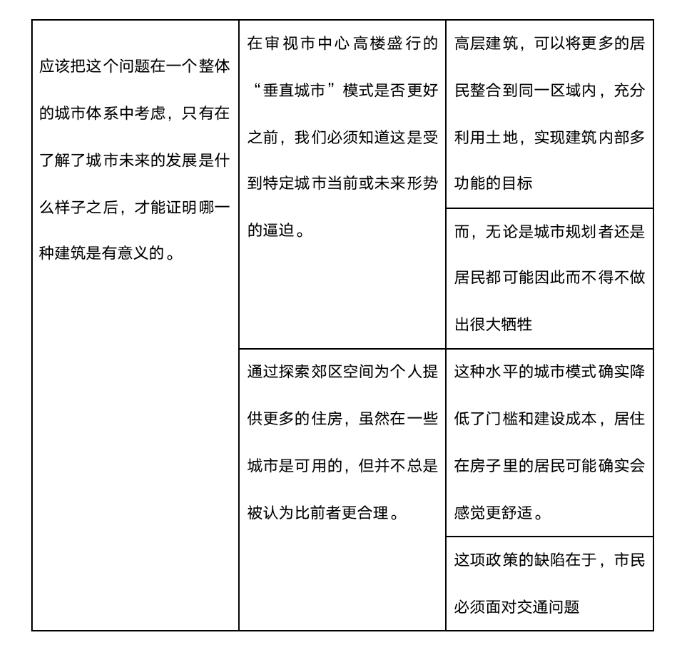Some people think city planners should provide taller buildings; others think they should create houses by exploring new land. Which one is better?
题目大意
一些人认为城市规划者应该提供更高的建筑;另一些人认为他们应该通过探索新的土地来建造房屋。哪一个更好?
写作思路解析
要了解规划者是应该在城市中提供更高的建筑,还是应该扩大城市面积以容纳更多的房屋,首先应该把这个问题在一个整体的城市体系中考虑,只有在了解了城市未来的发展是什么样子之后,才能证明哪一种建筑是有意义的。
在审视市中心高楼盛行的“垂直城市”模式是否更好之前,我们必须知道这是受到特定城市当前或未来形势的逼迫。不管有些人如何欣赏在高海拔上获得的风景,建造摩天大楼的唯一原因是有限的城市土地面积和激增的人口之间的冲突。与传统建筑相比,在既没有提供足够的居住空间,也没有形成连接郊区的快速交通工具的城市里建造的高层建筑,可以将更多的居民整合到同一区域内,充分利用土地,实现建筑内部多功能的目标。然而,无论是城市规划者还是居民都可能因此而不得不做出很大牺牲。由于施工困难,这种类型的建筑比建造房屋成本更高,涉及的劳动力更多。对于居民来说,他们不得不接受相对拥挤的居住环境和生活安全方面的局限性:现代救援系统无法防止住户在发生灾害(如火灾)时被困在高层建筑中。
上面列出的建筑形式在大多数城市中心都是一种常见的情景和被迫的选择,那里的土地是宝贵的,住房需求也是严峻的。然而,通过探索郊区空间为个人提供更多的住房,虽然在一些城市是可用的,但并不总是被认为比前者更合理。与高层建筑不同,这种水平的城市模式确实降低了门槛和建设成本,居住在房子里的居民可能确实会感觉更舒适。这种类型的建筑使用户能够更独立地生活,并拥有相对更充足的生活空间。这项政策的缺陷在于,市民必须面对交通问题;居住在新土地意味着远离城市中心或其他主要功能地点,而一个新地方总是需要数年时间才能繁荣起来。除非交通系统足够畅通,否则这些房屋居民可能不得不付出与市中心隔绝的代价,并至少在很长一段时间内忍受这种不便。
正如大多数事情一样,我会认为,选择这两种模式可能需要在两种建筑类型的积极结果和副作用之间取得平衡。这种考虑也与具体城市的具体安排相联系。规划者应该彻底检查高层建筑是否能够满足其市民的所有要求,以及这些问题是否可以克服,或者,另一方面,所探索的新区域是否能够有效地与城市的主要部分相连。无论是哪种情况,他们都应该确保城市模式的优点能超过缺点。
提纲
写作示范
To access whether planners should provide taller buildings in the city or expand the city area for more houses, one should first consider it inside a holistic urban system; only after knowing what the city would be like in its future development should a type of building be proved meaningful.
Before scrutinizing whether a “vertical city” mode, through which taller buildings prevail in the urban center, is better, we must know that it is forced by the current or future situation of specific cities. No matter how some would enjoy viewing the scenery gained at a high altitude, the only reason for constructing a skyscraper is the conflict between the limited urban land area and the proliferating population. Compared with traditional architectures, a high-rise building erected in cities that neither provide enough room for living, nor form a fast transport connected to suburbs can integrate more residents within the same area, make full use of land, and achieve a goal of multi-function inside a structure. However, both city planners and residents may have to sacrifice a lot due to this. Because of the construction difficulties, this building type is higher-cost and involves more labor force than building houses. As for the residents, they have to reconcile themselves to the relatively crowding living environment and the limitation in terms of living safety: modern rescue system is still out of the ability to prevent all inhabitants from being stuck in high-rise buildings when disasters (such as a fire) happen.
The architectural form listed above is a common scenario and a forced-choice in most urban centers where the land is cherished, and the housing demand is severe. However, to provide individuals with more houses via exploring suburban spaces, though available in some cities, is not always considered more rational than the former. Unlike tall buildings, such “horizontal city”mode indeed lowers down the barriers and costs of construction, and residents living in houses may indeed feel more comfortable. This type of building enables users to live more independently and to have a relatively more adequate living space. The flaw of the policy is that citizens have to face traffic problems; living in new lands means a distance away from urban centers or other major functional locations, and it always takes years for a new place to prosper. Unless the transport system is fluent enough, those house residents may have to pay the price of being isolated from the downtown and enduring the inconvenience at least for a long while.
Like most things, I would argue that the choice between the two alternatives may have to depend on the balance between the positive outcomes of both building types and the side effects of them. Such consideration is also linked with the concrete arrangement of a specific city. Planners should thoroughly examine whether tall buildings can fulfill all the requirements of their citizens and whether the problems can be overcome, or, on the other hand, the new area explored can be efficiently connected to the main parts of the city. Whichever the case is, they should ensure the merits of the city mode should dwarf the shortcomings.


